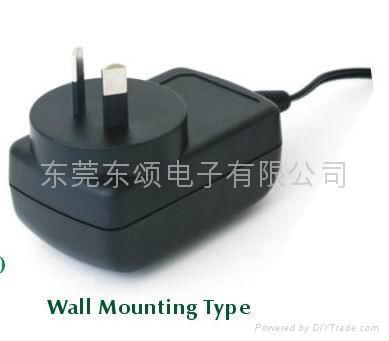Check and measure various power supply voltages of pc

$~Theory ~$
The PC power supply is primarily designed simply to take AC from the wall outlet & convert into the much lower DC voltages needed by the system. When system shut down, it must prevent any voltage overshoot & fluctuations so that none of sensitive circuits are exposed to any damaging voltage fluctuation .It must include some way of providing cooling air flow, because of the conversion process always has some heat by product.
$~Converting AC to DC power~$
The switching mode power supply used in a PC is much lighter & more efficient then the more common linear mode power supplies. Often used in the past systems, & therefore is a good choice for a power supply. The first part of PC switching power supply is rectifier. Next is the switches circuit which chops up .the input voltage at a frequency much higher than the AC supply. Further more, any load fluctuation are fed back to the input in such away as to cause switcher circuit to adjust the input power to the transformer so that it can maintain the output voltage to final regulator. The switcher circuitry it self generate EMI, which can feed back into the building AC power & contribute to problems elsewhere.

Figure ~ Liner ModePower Supply
 Figure~ Switching Mode Power Supply
Figure~ Switching Mode Power Supply
$~ Output voltage supply voltage lines ~$
The voltages delivered by the power supply to the motherboard must remain stable in spite of a wide range of input AC voltage and varying load conditions
$~ +5 volt supply ~$
This is the basic supply voltage for nearly all-electronic components. The 5V supply is now sometimes used by motors, but usually only in smaller drives, such as “2.5inch” & some 3.5inch drive. The +5V supply wires should always be red in any standard PC system.If regulated voltage is adjustable, the jumpers or switches will probably be found near regulator circuit.
$~ +12V power supply ~$
This line supplies most if not all, motors in the system, from drive motor to cooling fans. Because motors often used up to 50% more power on start up then while running ,the +12V supply may show adequate operation while running , but be in an over loaded condition during the 5 seconds or so immediately .after the system or a particular drive is turned on .
$~ -12 V power supply ~$
This supply line is usually used for some of the same communications circuits that use +12 V line.
$~ -5 V power supply ~$
This voltage is no longer used by any device and is retained only the purpose of backward compatibility with the older ISA slots. Originally, this voltage was used by some DRAM memory chips in original PC design. Micro channel system omitted this voltage from the power supply entirely
$~ +3.3V power supply ~$
Starting with the ATX designed in 1995 any system with ATX compatible power supplies include a 3.3 volt supply line from the power supply to the motherboard. Currently most CPUs & DRAM used 3.3V as well as some PCI adapter cards.
$~ Power Supply Control Signals ~$
Although the primary function of the power supply is indeed to supply clean electrical power to systems, the power supply also interacts with the motherboard to perform an increasing number of functions, including CPU startup, system power down, voltage and temperature detection and other functions.
$~ Power Good Signal ~$
The signal is actually a logic level signal designed as a power supply output signal to the CPU circuitry, to start the CPU running.
$~ Power On ~$
Prior to the ATX standard, AT compatible power supplies either had the power switch mounted on the back or side of power supply itself ,or had a remote switch mounted on the front panel.
The power on signal wire is apart of ATX standard and carries only a low voltage logic level signal from the motherboard to the power supply, telling it when to turn on and when to turn off.